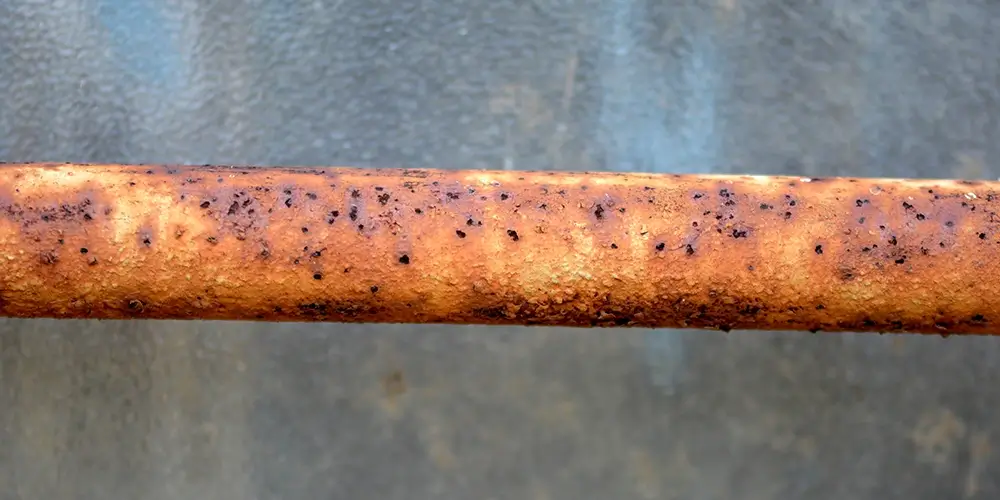You wouldn’t drink water from a dirty glass or grubby straw.
Yet, who knows what’s in your water when it passes through cracked and corroded pipes?
Damaged pipes are a gateway for contaminants, including lead, sediment, and even legionella bacteria. They seep into your water supply and wind up in your drinking glass.
If it has been a while since you paid for an inspection of your home’s main water line — the pipe connecting your home to the city supply — you might want to call in a professional. Not a golf pro, but a licensed and certified plumber with video cameras, acoustic devices, and other diagnostic equipment.
Here are ten signs that it may be time for replacement or repair:
1. Discolored Water
Water discoloration can indicate corrosion inside the pipe or sediment buildup, leading to clogged fixtures and appliances. Orange water signifies rust; sediment may color water yellow or brown.
2. Low Water Pressure
Does it take forever to fill a glass with water? Twigs, dirt, and other objects can lodge in the pipe, impeding water flow.
Sediment deposits also play a role in blockages. Minerals like calcium and magnesium accumulate and clog pipes. These smaller particles may not be visible to the naked eye but can still restrict the water flowing through your main water line.
3. Foul Odors & Taste in Your Water
The smell or taste of sulfur, rotten eggs, fuel oil, or sewage clearly shows contamination or a problem needing immediate professional attention. Drink bottled water and order takeout — don’t wash food or dishes in contaminated water.
4. Unusual Noises Coming from Plumbing Fixtures
Strange gurgling, burping, and thumping sounds from your plumbing fixtures are symptoms of an obstruction or a sediment build-up. Check the pressure gauge on your water heater — it should be between 8 and 12 psi. High pressure can cause a banging noise when you turn off a faucet.
5. Puddles Around Your Home’s Foundation; Slab Leaks
Unexplained puddles are exponentially worse when they appear in or around your home’s foundation.
These are telltale signs of a slab leak — a true plumbing nightmare. Slab leaks occur in the pipes in or under your home’s concrete slab foundation.
A tiny pinhole leak can erupt into a flood with little warning. At best, a slab leak will damage your home’s foundation and structure and promote black mold growth. At worst, it can make your home unliveable.
Call the plumber ASAP if you suspect a slab leak in your home. Early intervention is critical to limit the damage.
6. Flooding in Your Yard
When water inexplicably pools outside on a dry day, the source may be a leaking main water line.
In most homes, the water main passes under the front yard. Lush green spots in the front lawn should be viewed with suspicion when everything else has turned brown.
7. Visible Signs of Damage
Pipes with cracks, holes, corrosion, and rust spots should be relined or replaced. No exceptions!
As bad as the corrosion appears outside, it’s far worse inside. Guaranteed.
8. Old Age of Pipes
If your home is over 40 years old and has never been repiped, there’s a chance its main water line is made of asbestos cement or galvanized steel — materials prone to corrosion. High water pressure and ground shifting can also contribute to pipe deterioration.
Even the best pipes may last less than 50 years in Orange County’s hard water and soil conditions.
9. Spikes in Your Water Bill
High monthly water bills are often a clue that you have leaky pipes somewhere in your home — usually a slab leak near the foundation, where it’s hard to detect with the naked eye. You might consider an audit of your plumbing system to check for unseen problems.
10. Earthquakes; Recent Construction Projects Nearby
Shifting soil is never a good thing for underground plumbing. Earthquakes and vibrations from heavy equipment can make pipes move, leak, and break open.
Take all these signs seriously, and get help from a professional plumber who can inspect your system and offer the best solution.
Don’t wait until your home floods or turns into a petri dish for mold. Catching minor issues can save you thousands of dollars in repair costs in the long run.
Cure-in-Place Pipes: Rehab for Old Plumbing
Newer pipe replacement methods like cured-in-place piping (CIPP) are more affordable and less destructive than traditional methods.
CIPP is a trenchless form of pipe repair involving a resin-coated flexible tube inserted into the existing plumbing line to create a watertight seal. It eliminates the need to dig up your landscape or tear up concrete slab foundations — saving time, money, and headaches.
Orange Coast Plumbing offers CIPP for homes in Orange County and Southern California. Our licensed and certified technicians can provide expert diagnosis and repair services for your main water line before it causes expensive damage to your home.
FAQs: Replacing Your Main Water Line
Q: How long does a main water line usually last before it needs replacing?
Copper lines can last over 50 years, while polyvinyl chloride (PVC) pipes may have a shorter lifespan. Environmental factors and maintenance quality play significant roles.
Q: What materials are best for replacing a main water line?
Modern main water lines are typically made from copper, PVC (Polyvinyl Chloride), or PEX (Cross-linked Polyethylene). Each material has its advantages and suitability, depending on local conditions and water quality.
Q: Can I replace my main water line myself, or do I need a professional?
Replacing a main water line is a complex and potentially hazardous task that requires the expertise, tools, and certifications of a professional plumber or team experienced in municipal water systems.
Q: How much does replacing a main water line typically cost?
The cost varies widely depending on the length of the line, the material you choose, and the complexity of the installation itself.
Q: How are main water lines replaced?
Replacement techniques can include traditional trench digging or more modern, less invasive methods like trenchless pipe replacement. The best method depends on the location, soil type, and existing infrastructure.
Q: How long does it take to replace a main water line?
Depending on the project’s complexity, the replacement method used, and unforeseen challenges, this can range from a single day to several days.
Q: Will replacing my main water line disturb my yard?
Traditional trenching will significantly disturb your yard, while trenchless methods minimize excavation and damage to landscaping.
Q: Is it necessary to obtain permits to replace my main water line?
Yes, replacing a main water line typically requires permits from your local municipality or water authority to ensure the work complies with local codes and safety standards.
Q: How should I prepare for a main water line replacement?
Coordinate with your contractor to understand the scope of work and duration. During the construction process, you may have to clear the work area and keep pets and children at a safe distance.
Q: Can replacing my main water line improve the water pressure in my home?
If the existing water line is corroded or blocked, replacing it can significantly improve water pressure and flow quality to your home.
Q: What maintenance should be done after replacing a main water line?
After installation, regular monitoring for leaks and annual professional inspections can help maintain the integrity of your new main water line, extend its lifespan, and ensure consistent water quality and pressure.


